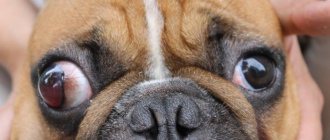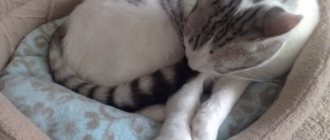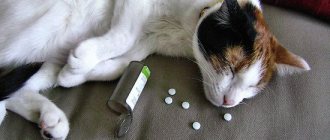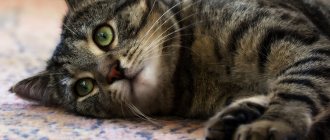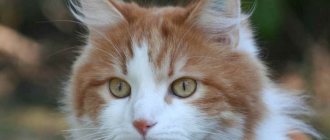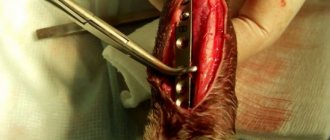May 14, 2020
One of the common reasons for pet owners to visit a veterinarian is when their pet falls from a window or from the balcony of their home.
The reason why cats fall from heights so often can be attributed to several factors. The first and perhaps most important is the carelessness of cat owners and misconceptions about feline behavior in general. Many people transfer their way of thinking to their pets and believe that they are fully aware of the dangers of certain actions and their possible consequences, so they cannot jump down from a window or simply fall. The idea of cats' agility does them a disservice because often their owners think that a pet simply cannot fall by tripping or miscalculating the height. In addition, the belief that cats always land on four paws lulls the vigilance of people who believe that even if the animal loses its balance, it will still land safely and remain unharmed.
Indeed, repeated experiments have revealed the reflexive ability of cats to take the desired position in the air to land on four paws, but this ability does not always save them from injury when falling. Not all cats are able to correctly orient their bodies in flight: kittens have not yet developed the appropriate reflexes; Severely obese cats are not very maneuverable in the air.
In addition, there are individual characteristics - not all animals have reflexes that work as they should. If a cat falls by accident, then it may simply not have time to orient itself and turn around in flight, and if it falls from a great height, the force of the impact will be enormous, and, regardless of what part of the body the animal lands on, it will receive serious injuries.
Symptoms of a cat falling from a height
Fractures and bruises
A bone fracture is associated with a complete or partial violation of its integrity. The main symptoms include pain, bone mobility, and dysfunction of the injured body part. The pain, very severe at the time of injury, becomes dull over time and may disappear when the animal is motionless.
The most striking manifestation of a fracture will be impaired mobility of the affected part of the body or limb: the cat will not be able to lean on the injured paw or chew food with the help of a broken jaw. The exception would be cases where a complete fracture has not occurred, but only a crack or other minor damage to the bone: in such a situation, the animal may not show any discomfort.
In the area of the fracture, the contours, size and shape of the broken bone may change, and even shortening of the limb may be observed. Such deformities can also occur with bruises, so it is important to fully examine the cat.
The main signs of a bruise will be pain, swelling, bruising and disruption of the functioning of the corresponding organ. Immediately after a bruise, dark purple bruises appear on the skin, resulting from ruptures of small vessels. Subsequently, the color of the damaged area will change to green, brown, and then yellow. Due to the release of blood and lymph from ruptured vessels and their pressure on surrounding tissues, pain and swelling appear, varying in intensity.
A bruise may also be accompanied by changes in the functioning of the damaged organ: lameness if a muscle is injured, sometimes paresis and paralysis if a nerve is damaged.
As a rule, a bruise does not affect the general condition of the cat, with the exception of extensive injuries.
Bleeding
Bleeding can occur either immediately after injury or over time. Blood from a damaged vessel can flow both into the external environment and into the animal’s body.
If an artery is damaged, bright scarlet blood gushes out of the wound like a fountain; with venous bleeding, cherry-colored blood flows in a thick stream; blood dripping from the wound is a sign of capillary damage.
Internal bleeding is the most difficult to recognize, since its source is not visible, but it can be suspected by pale mucous membranes, shortness of breath, and increased abdominal volume.
Traumatic brain injuries
Symptoms accompanying a head injury can be varied depending on its nature, the location of the damaged area of the brain, and the general condition of the animal.
With the mildest of injuries - a concussion - only a short-term loss of consciousness occurs; contusion of the brain and rupture of its tissues may be accompanied by stupor and coma. The following signs will indicate brain damage: changes in pupil size (both dilation and constriction), changes in breathing rate or its disappearance, abnormal heart rhythm, unnatural position of body parts.
First aid for a cat falling from a height
When you find a cat that has fallen from a height, it is important to remember that after the fall it is most likely in a state of shock and can show aggression even towards a person you know well, so it is important to take care of your safety: if possible, wrap your hands in some kind of cloth, protect your face and neck.
If it is not possible to immediately go to a veterinary clinic, the cat must be moved to a warm, quiet place and provided with peace. When transporting an animal, you need to limit its mobility as much as possible; it is best to place the cat on a hard, flat surface (for example, on a board or piece of cardboard); it’s good if you can tie the animal to prevent it from moving, you can use adhesive tape. It is better to place the cat on its side so that, in case of vomiting, the vomit does not enter the respiratory system.
If the cat is bleeding heavily, a pressure bandage should be applied in its place; if the blood is gushing out like a fountain, a tourniquet can be applied above the site of the ruptured vessel. It is important to remember that it is not advisable to keep the tourniquet for more than 1.5 hours in the warm season and 1 hour in the cold season.
You should not give your cat any medications - using them without special knowledge can only harm the animal. And, of course, it is necessary to take the cat to a veterinary clinic as soon as possible, even in the absence of visible injuries - only a veterinarian can assess the cat’s condition and the presence of invisible consequences of injury, such as a ruptured bladder, pneumothorax, pulmonary edema, etc.
How do cats fall?
Most cats know how to regroup in flight so that they fall on their paws. But not all cats have this ability: for example, ragdolls do not know how to regroup, so for them even a fall from a wardrobe can be fatal. For others, regrouping is not a guarantee of survival.
Article continues after advertisement
If you compare cats and people, the difference is also in weight. After all, cats are lighter, so the impact force also decreases.
In addition, cats have an internal “device” that allows them to orient themselves in flight and rotate 180 degrees. First, the cat, turning around its axis with its paws down, stretches them out and arches its back. In this case, cats can spread out in the air like flying squirrels, like parachutists, thereby slowing down their flight speed. The tail, which is intended for this purpose, also allows maneuvering.
Once the cat has turned its paws down and assumed a position comfortable for falling, it prepares to meet the ground. First, the paws come into contact with it, as the least valuable parts of the body, then the cat’s movement towards the ground may end - then no more parts of the body will take the blow. But it happens that the shock-absorbing capacity of the paws is not enough, then the cat also hits the ground with its muzzle. Next, the torso suffers. Whether this is so or whether the cat lands on its paws and runs calmly for longer depends on many factors: its initial state, the surface under the windows, obstacles encountered during the flight and, of course, it depends on the height of the fall.
Diagnostic methods in the clinic
What will need to be done to diagnose the cat's condition at the veterinary clinic will depend on the severity and nature of the injuries.
The veterinarian will examine the animal, measure basic vital signs, assess the patient’s general condition, and whether the pet’s life is currently in danger. In any case, even in the absence of visible injuries, an X-ray examination will be necessary: it will help assess the condition of the bones and respiratory system (presence of pneumothorax, pulmonary edema, etc.).
Ultrasound examination (ultrasound) is also performed to assess the condition of internal organs. Further diagnosis will depend on the presence, nature and severity of specific injuries.
Consequences
If a cat falls from the third floor or lower, then in most cases there are no serious consequences. The animal is in shock for a while and then lives a normal life.
If you jump from the sixth, seventh or higher floors, the risk of serious damage increases significantly. The consequences of a cat falling from a height are immediate and secondary.
The first group includes arrest of the respiratory process and heart, serious blood loss, and shock.
Secondary consequences arise after some time. These include inflammatory processes in internal organs, impaired functioning of the kidneys and liver, infections entering the wounded surface, and blood poisoning.
With correct and timely assistance, negative consequences rarely occur.
Important! It is necessary to quickly take your pet to the hospital to reduce the risk of developing malfunctions in the functioning of organs and systems.
Consequences of a cat falling from a height
Shock
Traumatic shock is a complex reaction of the body to damage, accompanied by depression of the nervous system and all vital functions. It is observed in most patients after a fall from a height and is a life-threatening condition.
Shock develops in response to damage to soft tissues and blood loss: the flow of pain impulses entering the cerebral cortex causes its depletion and inhibition that is prohibitive in its strength.
In a state of shock, the cat first becomes extremely excited, then, on the contrary, depressed, not responding to external stimuli, its muscles are relaxed, it cannot fully move, the temperature is low, the pulse is weak, the mucous membranes are pale.
Treatment will be aimed primarily at stopping the flow of pain impulses into the central nervous system and protecting it from further damage. Sleeping pills and narcotics, blockades, drugs that tonic the cardiovascular system can be used, infusion therapy is carried out, and, if necessary, blood transfusions.
Pneumothorax
After a fall as a result of injury, a cat may develop a pathological condition caused by the accumulation of air in the chest cavity - pneumothorax.
The collapse of lung tissue, compression of blood vessels, and displacement of structures located in the chest cavity that occurs under the influence of this condition can lead to death. With pneumothorax, signs of respiratory failure are observed: difficult or absent breathing, pallor or cyanosis of the mucous membranes.
In such conditions, as a rule, air is removed from the chest cavity, after which the patient is given oxygen therapy.
Fracture of the spine, pelvis, limbs, jaw
Most often, falls from a height cause fractures of the front and rear limbs. How severe the consequences of such an injury will be is determined by the nature of the fracture: the degree of displacement of bone fragments relative to each other, the presence and number of fragments, etc.
Treatment is almost always carried out by osteosynthesis, with the exception of fractures of the small bones of the fingers - they are often treated conservatively by limiting mobility.
A spinal fracture is dangerous primarily due to damage to the spinal cord. When it ruptures, the conduction of nerve impulses from the brain to the body is disrupted, which can lead to the death of the cat or its disability.
Trauma in pets can cause pelvic fractures. It is accompanied by lameness of one or two hind limbs, the cat may not even rest on its hind legs at all, and severe pain in the sacrum area.
The method of treatment depends on the location of the fracture site and the presence of damage to organs located inside the pelvic cavity. Treatment can be either conservative or surgical
A jaw fracture in a cat is dangerous because the animal cannot eat properly; in addition, vital structures are located nearby: the respiratory system, brain, etc. This type of fracture can also be treated with surgery.
Cleft palate
As a result of a fall from a height, a hole of various sizes can form in the hard palate. The severity of this pathology will be determined by whether the oral and nasal cavities communicate as a result of the rupture.
If this happens, then the entry of food particles into the nasal cavity and, accordingly, the respiratory system will cause deadly aspiration pneumonia. In such cases, the only possible way to save the cat is surgery, which must be performed as soon as possible. If the resulting rupture is not that serious, then treatment may not be required.
Rupture and bleeding of internal organs
After a cat falls from a height, ruptures of the abdominal organs often occur: most often the spleen or liver are ruptured, which leads to severe internal bleeding, as well as the bladder, which entails urinary peritonitis, which occurs due to urine entering the abdominal cavity.
Most often, such conditions require immediate surgical treatment, otherwise the cat's death is likely.
Traumatic brain injuries
A cat falling from a height is one of the most common causes of this type of injury. Traumatic brain injuries are very diverse in nature and clinical manifestations, and can cause severe and life-threatening conditions.
Brain damage can occur at different levels, both immediately after injury and over time due to a series of chemical reactions in the animal's body. Immediately after a cat falls from a height, primary brain damage may occur as a result of exposure to the damaging factor itself.
The mildest of these will be a concussion, in which there is no damage to brain tissue. A more serious injury would be a brain contusion - it leads to parenchymal bleeding and edema.
Brain rupture - the most severe consequence of injury - is accompanied by damage to brain tissue, as a result of which hematomas appear in the parenchyma and the spaces surrounding it, compressing nerve fibers, which leads to disruption of their functioning and neurological dysfunction.
After an injury, in the absence of timely assistance, secondary brain damage may occur. The factors that cause them will be low pressure, lack of oxygen, depletion of energy reserves, exchange of microelements and organic compounds, which occurs as a response of the body to tissue damage, etc. To prevent such a scenario, appropriate therapy is carried out aimed at saturating tissues with oxygen, supplying the body with the necessary solutions, and treating increased intracranial pressure. At the same time, the patient's neurological status is constantly monitored.
Analysis of the cat's condition after a fall
The main mistake that cat owners make after they fall is paying attention to superficial factors. A pet that has experienced such an event is expected to howl in pain, bleed, and die in agony, which is unlikely to happen. Even after falling from an impressive height, a pet may seem completely unharmed to its owners. But is this really so?
Cats can behave differently after a fall
Most of the most dangerous injuries that a free fall can cause are hidden and occur without obvious symptoms. It is also worth remembering a key feature of cats - they do not like to demonstrate their physical vulnerability and inform their owner about injuries. Therefore, regardless of how healthy the behavior of a pet who has survived a fall, you should immediately show it to a veterinarian.
State of shock
It is fair to assume that a cat that has experienced such a great shock is in a state of shock. Therefore, the first attempts to pick him up, caress him and calm him down end in failure for the owner. The animal can grab your face, hands, bite painfully and immediately run away. The reason for this will not be spontaneous anger at the owner, but a state of complete disorientation, in which the pet risks harming itself even more.
A cat in shock is ready to attack anyone who catches its eye
Therefore, before catching your pet, make sure to take a pair of thick gloves with you. It is advisable to pick up a lost cat together with an assistant who will help, if necessary, curb the raging pet.
Prevention
Of the entire list of animal life-threatening conditions encountered by veterinarians, cats falling from a height are distinguished by the ease of preventing such an accident.
To prevent such an incident, it is enough not to let the cat go for a walk on the open balcony and make sure that the windows are closed. Unfortunately, the ventilation mode is no less dangerous for cats: getting a pet stuck between the frames can lead to numerous injuries and often death.
All cat owners are recommended to install special metal mesh on their windows - only they can support the weight of the cat if he wants to go outside. Balconies and loggias must be glazed or cats must not be allowed onto them. If your pet is careless and may fall, for example, from a high cabinet, it is better to limit the cat’s access there.
It is important to remember that the hunting instinct can always be stronger than caution, and previous bad experiences rarely affect cats, so the fact that a cat has already fallen from a window, unfortunately, will not stop it next time, so you should never let your guard down; The best prevention is a responsible attitude towards the animal.
Back
How to protect your animal from an accident
The hunting instinct and natural curiosity cannot be taken away from cats, so you can only protect the cat. Firstly, all windows must be fitted with metal mesh that will be securely fastened. Mosquito nets will not prevent your cat from falling. Secondly, glazing the balconies and, if desired, equipping them with wooden slats outside the window, so that the cat can cling to them with its claws if it falls out of the balcony. Thirdly, you should try to control your pets and not open windows unless absolutely necessary. And do not forget that after the first fall, this can happen again and it is not a fact that the second and subsequent times the landing will be successful.
Author of the article: Veterinary therapist Elena Sergeevna Avdasheva


